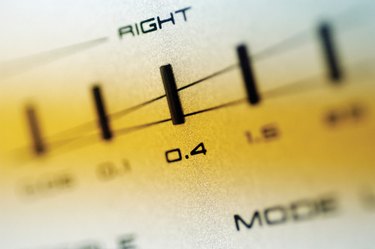
Spotify is one of a number of online audio streaming services that enable registered users to listen to their favorite music at the click of a button. However, it is not possible to save tracks directly to your computer. To do this, you need to record the computer's audio using a sound recording program such as Audacity, which is a free download.
Set Up Input Sound Levels
Video of the Day
Step 1
Open the Spotify application on your computer, select the music track you wish to record and press the "Play" button. Monitor its playback through the computer's speakers.
Video of the Day
Step 2
Open the Windows Control Panel. Under the "Hardware and Sound" category, select "Sound" followed by the "Manage Audio Devices" option. Click the "Recording" tab to ensure that the "Stereo Mix" audio device option is selected (this enables recording of the speaker output). Note that this interface varies according to the version of Windows you use. Click "Apply" to accept the settings.
Step 3
Adjust the computer's sound levels by opening "Volume Mixer" in the "Sound" sub-set of "Manage Audio Devices" and adjust the slider control to decrease or increase the "Speakers" audio level. This should not exceed the indicated level or distortion will be present in your recording. Note that there is a separate input control for Audacity (Windows 7 and Vista), which should be used to ensure that the level is neither too high nor too low. Close the Control Panel.
Recording With Audacity
Step 1
Open Audacity. With the Spotify track playing, click the drop-down tab beside the "Microphone" symbol near the top right of the program's interface. Select the "Monitor Input" option — this acknowledges the presence of a suitable input sound level from Spotify. If each of the two linear meters displays a moving green and red indicator respectively, an input signal is present. If not, check the Control Panel input settings once more or refer to your hardware user guide.
Step 2
Reduce the Sound Playback level by sliding the "Speaker" fader (in the upper left of the Toolbar) to zero to prevent feedback while monitoring and recording. Slide the "Microphone" fader to its midpoint in readiness to make a test recording.
Step 3
Click the red "Record" button to commence a short test recording. Monitor the bright blue waveform display closely as it is written into the Audio Track and progressing from left to right. Increase or decrease the input level to a point where it is neither too high nor too low. After approximately 10 seconds click the square "Stop" button.
Step 4
Slide the sound playback level control up and click the green "Play" button to listen to your test recording, increasing the playback volume as required. If the top and bottom of the blue waveform is a straight line and the recorded sound level is distorted, the recorded sound level is excessive. Make another test recording with a reduced input level and test again until you achieve a satisfactory result.
Step 5
Close the Audio Track containing your test recordings by clicking the "X" symbol in its left margin in readiness to make a new, complete recording. Reselect your chosen track in Spotify and press "Pause" in readiness to play it. Click Audacity's red "Record" button, closely followed by "Play" in Spotify in order to commence recording. On completion, stop each application. In Audacity, save your recording as a WAV (Wave) file on your computer.